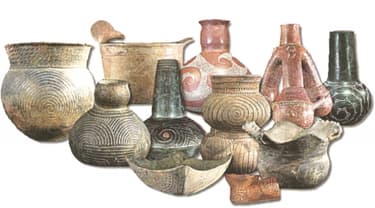Explain why most of the chemical changes are irreversible.
Important Questions on Physical and Chemical Changes
A. Read the following passage and answer the following question:
Pottery
Pottery is one of the oldest human technologies. For a very long time, it is used to make vessels, pots and figurines for various purposes.
There are different types of pottery.
Earthenware is used extensively for making earthenware and decorative objects. It is one of the oldest materials used in pottery. This is made by firing clay to make a coarse and porous object, which is then coated by a glaze made by suspending glass powder in water. Then it is fired again. Stoneware clay is fired till it gives a glass like appearance. It is non-porous, so glaze is applied only for decoration. It is a sturdy, chip-resistant and durable material suitable for use in the kitchen for cooking, baking, storing liquids and as serving dishes. Porcelain is a very hard, translucent and white ceramic. The earliest forms of porcelain originated in China around , and by , Chinese porcelain was a prized commodity with Arabian traders. It was used to make plates, cups, vases and other works of fine art. It is often called ‘fine china’. To make porcelain, small amounts of glass, granite and feldspar minerals are ground up with fine white clay. Water is then added to the resulting fine white powder so that it can be kneaded and worked into shape. This is fired in a kiln to between Decorative glazes are then applied followed by further firing. Bone china - which is easier to make, harder to chip and stronger than porcelain - is made by adding ash from cattle bones to clay, feldspar minerals and fine silica sand.
Name four types of pottery materials.
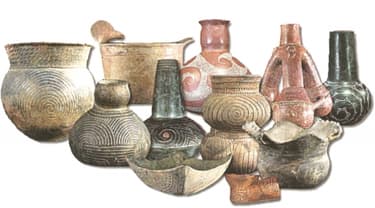
A. Read the following passage and answer the following question:
Pottery
Pottery is one of the oldest human technologies. For a very long time, it is used to make vessels, pots and figurines for various purposes.
There are different types of pottery.
Porcelain is a very hard, translucent and white ceramic. The earliest forms of porcelain originated in China around , and by , Chinese porcelain was a prized commodity with Arabian traders. It was used to make plates, cups, vases and other works of fine art. It is often called ‘fine china’. To make porcelain, small amounts of glass, granite and feldspar minerals are ground up with fine white clay. Water is then added to the resulting fine white powder so that it can be kneaded and worked into shape. This is fired in a kiln to between Decorative glazes are then applied followed by further firing.
Bone china - which is easier to make, harder to chip and stronger than porcelain - is made by adding ash from cattle bones to clay, feldspar minerals and fine silica sand.
Which is the common ingredient of all types of pottery?
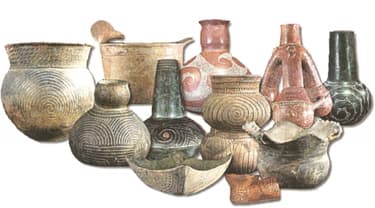
A. Read the following passage and answer the following question:
Pottery
Pottery is one of the oldest human technologies. For a very long time, it is used to make vessels, pots and figurines for various purposes.
There are different types of pottery.
Porcelain is a very hard, translucent and white ceramic. The earliest forms of porcelain originated in China around , and by , Chinese porcelain was a prized commodity with Arabian traders. It was used to make plates, cups, vases and other works of fine art. It is often called ‘fine china’. To make porcelain, small amounts of glass, granite and feldspar minerals are ground up with fine white clay. Water is then added to the resulting fine white powder so that it can be kneaded and worked into shape. This is fired in a kiln to between Decorative glazes are then applied followed by further firing.
Bone china - which is easier to make, harder to chip and stronger than porcelain - is made by adding ash from cattle bones to clay, feldspar minerals and fine silica sand.
How is fine china made?
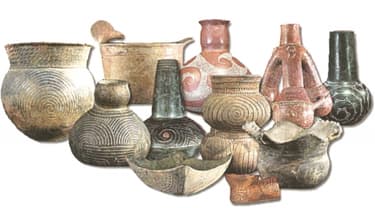
A. Read the following passage and answer the following question:
Pottery
Pottery is one of the oldest human technologies. For a very long time, it is used to make vessels, pots and figurines for various purposes.
There are different types of pottery.
Porcelain is a very hard, translucent and white ceramic. The earliest forms of porcelain originated in China around , and by , Chinese porcelain was a prized commodity with Arabian traders. It was used to make plates, cups, vases and other works of fine art. It is often called ‘fine china’. To make porcelain, small amounts of glass, granite and feldspar minerals are ground up with fine white clay. Water is then added to the resulting fine white powder so that it can be kneaded and worked into shape. This is fired in a kiln to between Decorative glazes are then applied followed by further firing.
Bone china - which is easier to make, harder to chip and stronger than porcelain - is made by adding ash from cattle bones to clay, feldspar minerals and fine silica sand.
What are the constituents of bone china? Why is it called so?
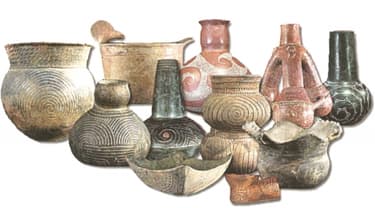
A. Read the following passage and answer the following question:
Pottery
Pottery is one of the oldest human technologies. For a very long time, it is used to make vessels, pots and figurines for various purposes.
There are different types of pottery.
Porcelain is a very hard, translucent and white ceramic. The earliest forms of porcelain originated in China around , and by , Chinese porcelain was a prized commodity with Arabian traders. It was used to make plates, cups, vases and other works of fine art. It is often called ‘fine china’. To make porcelain, small amounts of glass, granite and feldspar minerals are ground up with fine white clay. Water is then added to the resulting fine white powder so that it can be kneaded and worked into shape. This is fired in a kiln to between Decorative glazes are then applied followed by further firing.
Bone china - which is easier to make, harder to chip and stronger than porcelain - is made by adding ash from cattle bones to clay, feldspar minerals and fine silica sand.
From the above passage, pick up 5 examples of physical and chemical changes.
